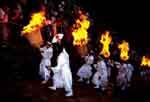 This festival is also called 'Ogi Matsuri (fan
festival)'. In this festival 12 big blazing torches are
carried up and down in circles on the stonesteps at the
base of the Nachi Waterfall to purify 12 Ogi mikoshi ('portable
fan shrines'). Nachi no Hi Matsuri (Ogi Matsuri), which
used to be called Ogieshiki, is one of the many festivals
held regularly at the Kumano Nachi Grand Shrine
throughout the year.
This festival is also called 'Ogi Matsuri (fan
festival)'. In this festival 12 big blazing torches are
carried up and down in circles on the stonesteps at the
base of the Nachi Waterfall to purify 12 Ogi mikoshi ('portable
fan shrines'). Nachi no Hi Matsuri (Ogi Matsuri), which
used to be called Ogieshiki, is one of the many festivals
held regularly at the Kumano Nachi Grand Shrine
throughout the year.  The festival
falls on July 14 each year. In the morning there are
ritual Shinto offerings such as the Nachi no Dengaku and
Yamatomai (traditional music and dance). In the afternoon
the 12 Ogi mikoshi ('fan portable shrines') and the 12
big torches are carried towards the Hiryu Shrine near
Nachi Waterfall. At first, a sacred ritual is held at the
shrine. Then the torches are lit at the the base of Nachi
Waterfall. The torches are then carried up and down in
ritual procession to purify the portable shrines, which
are also purified by the mist coming off the waterfall
itself. It is said that this is how the gods of Kumano
make their annual journey to their original 'palace', the
Nachi Waterfall, to revive themselves before returning to
their shrines.
The festival
falls on July 14 each year. In the morning there are
ritual Shinto offerings such as the Nachi no Dengaku and
Yamatomai (traditional music and dance). In the afternoon
the 12 Ogi mikoshi ('fan portable shrines') and the 12
big torches are carried towards the Hiryu Shrine near
Nachi Waterfall. At first, a sacred ritual is held at the
shrine. Then the torches are lit at the the base of Nachi
Waterfall. The torches are then carried up and down in
ritual procession to purify the portable shrines, which
are also purified by the mist coming off the waterfall
itself. It is said that this is how the gods of Kumano
make their annual journey to their original 'palace', the
Nachi Waterfall, to revive themselves before returning to
their shrines.
to the top
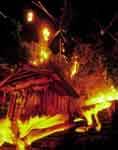 This festival has a 500 year old
history and is held in the Kongoin Temple at
Nikawa, in Yukawa, which is in the district of
Nachikatsuura Town. This festival is held during
the period of the Bon Festival (a traditional
Buddhist festival held in mid-summer for
honouring one's ancestors). This fire festival is
to console the souls of the young men who
sacrificed themselves in a conflict with a
neighboring village over a land issue. This is an
exciting fire festival in which young men throw
flaming pine torches up into the air creating a
spectacular sight. At 7 o'clock in the evening
the young men, dressed in white costumes and
headbands, light their torches and run up toward
the Megami Hachiman Shrine, where they throw
their torches toward a wire attached to a steel
pole. The torches illuminate the mountainside
making great arcs of light as they burn away. It
is an exciting and beautiful festival of which
the locals are very proud.
This festival has a 500 year old
history and is held in the Kongoin Temple at
Nikawa, in Yukawa, which is in the district of
Nachikatsuura Town. This festival is held during
the period of the Bon Festival (a traditional
Buddhist festival held in mid-summer for
honouring one's ancestors). This fire festival is
to console the souls of the young men who
sacrificed themselves in a conflict with a
neighboring village over a land issue. This is an
exciting fire festival in which young men throw
flaming pine torches up into the air creating a
spectacular sight. At 7 o'clock in the evening
the young men, dressed in white costumes and
headbands, light their torches and run up toward
the Megami Hachiman Shrine, where they throw
their torches toward a wire attached to a steel
pole. The torches illuminate the mountainside
making great arcs of light as they burn away. It
is an exciting and beautiful festival of which
the locals are very proud. to the top |
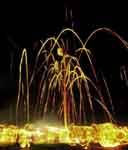 This is another fire festival where people throw
little fire torches into a basket at the top of a tall
cedar pole located in the center of a local square. The
photo shows 'Hashiramatsu in Iruka' near Kiwa Town. This
festival was originally held as a means to exorcise those
diseased by a plague. This festival can be seen not only
in Kiwa Town but also in Taiji Town, Sano (in Shingu
City), and in Ehime Prefecture. They are all held around
the time of the Bon Festival in August and according to
the lunar calendar. This festival is open to everybody,
so you may wish to experience the 'healing fire' of this
Bon Festival yourself.
This is another fire festival where people throw
little fire torches into a basket at the top of a tall
cedar pole located in the center of a local square. The
photo shows 'Hashiramatsu in Iruka' near Kiwa Town. This
festival was originally held as a means to exorcise those
diseased by a plague. This festival can be seen not only
in Kiwa Town but also in Taiji Town, Sano (in Shingu
City), and in Ehime Prefecture. They are all held around
the time of the Bon Festival in August and according to
the lunar calendar. This festival is open to everybody,
so you may wish to experience the 'healing fire' of this
Bon Festival yourself. to the top
- Kamikura Shrine
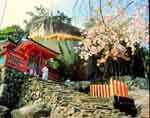 The Oto Matsuri is an important regional
festival which is held every year on the 6th of
February and is one of the two great 'fire
festivals' of Kumano. The other one is Nachi Ogi
Matsuri, held in the summer. The Oto Matsuri
culminates at Kamikura Shrine which is located on
the side of Chihogamine Mountain overlooking
Shingu City. In this exciting and somewhat
dangerous festival almost 2000 men gather bravely
at the upper shrine before running down long and
steep stone steps at breakneck speed with blazing
torches in hand. This part of the festival is
described in a local song which sings, 'The
mountain is covered with a falling stream of
fire, descending like a dragon.' The origin of
this festival goes back to the Nara Era, and it
is said to have a lot to do with Mountain
Buddhism which considers fire as a sacred symbol.
The festival is open to all men, young and old
regardless of origin. Recently more and more
people are coming from the big cities like Osaka
and Tokyo to join in the festivities.
Non-Japanese have also been known to participate.
The Oto Matsuri is an important regional
festival which is held every year on the 6th of
February and is one of the two great 'fire
festivals' of Kumano. The other one is Nachi Ogi
Matsuri, held in the summer. The Oto Matsuri
culminates at Kamikura Shrine which is located on
the side of Chihogamine Mountain overlooking
Shingu City. In this exciting and somewhat
dangerous festival almost 2000 men gather bravely
at the upper shrine before running down long and
steep stone steps at breakneck speed with blazing
torches in hand. This part of the festival is
described in a local song which sings, 'The
mountain is covered with a falling stream of
fire, descending like a dragon.' The origin of
this festival goes back to the Nara Era, and it
is said to have a lot to do with Mountain
Buddhism which considers fire as a sacred symbol.
The festival is open to all men, young and old
regardless of origin. Recently more and more
people are coming from the big cities like Osaka
and Tokyo to join in the festivities.
Non-Japanese have also been known to participate.
to the top- Shiogori Purification Celemony
 The men who
participate in the Oto Matsuri festival are
called 'Noboriko'. In order to purify themselves
Noboriko are traditionally supposed to eat
nothing but white food such as tofu, white
fishcake, white rice, sake, and so on (white
having the symbolic meaning of purity in Japan).
There also used to be a custom of doing
'Shiogori' at 'Ojigahama' beach. This is a
ceremony in which the Noboriko seek to purify
themselves in the salt water of the sea before
dressing up in the traditional costume of the
festival. Today, a number of Kumano enthusiasts
are attempting to revive this part of the
festival by gathering at the beach to perform the
traditional ceremonies as in ancient times.
The men who
participate in the Oto Matsuri festival are
called 'Noboriko'. In order to purify themselves
Noboriko are traditionally supposed to eat
nothing but white food such as tofu, white
fishcake, white rice, sake, and so on (white
having the symbolic meaning of purity in Japan).
There also used to be a custom of doing
'Shiogori' at 'Ojigahama' beach. This is a
ceremony in which the Noboriko seek to purify
themselves in the salt water of the sea before
dressing up in the traditional costume of the
festival. Today, a number of Kumano enthusiasts
are attempting to revive this part of the
festival by gathering at the beach to perform the
traditional ceremonies as in ancient times.
to the top- Costuming
 The costume worn
by the Noboriko is all white and participants
wear waraji, which are hand woven straw sandals.
A thick straw rope is wrapped around their waist
in order to protect the participants in case they
fall down the steep stone steps as they run down
to the lower gate of the Kamikura Shrine. To be
wrapped in the sacred rope also signifies the
process of being purified.
The costume worn
by the Noboriko is all white and participants
wear waraji, which are hand woven straw sandals.
A thick straw rope is wrapped around their waist
in order to protect the participants in case they
fall down the steep stone steps as they run down
to the lower gate of the Kamikura Shrine. To be
wrapped in the sacred rope also signifies the
process of being purified.
to the top- Taimastu(Torches)
 The torches that
the participants carry are about 1 meter long,
made of Japanese cypress, with long wood
shavings, called 'hana', attached to their tips.
Each participant has his prayers written on his
torch such as 'Thriving Business' or 'May I
achieve my special wish'. After the festival is
over, the participants will place the remains of
their burned torches in the Shinto altars that
you can see in most homes in Japan. It will be
kept there for one year. The little torch on the
left in the photo is used by people who are
unable to physically participate in the festival.
They write their prayers on it and ask a friend
who will participate to take this torch along
with him.
The torches that
the participants carry are about 1 meter long,
made of Japanese cypress, with long wood
shavings, called 'hana', attached to their tips.
Each participant has his prayers written on his
torch such as 'Thriving Business' or 'May I
achieve my special wish'. After the festival is
over, the participants will place the remains of
their burned torches in the Shinto altars that
you can see in most homes in Japan. It will be
kept there for one year. The little torch on the
left in the photo is used by people who are
unable to physically participate in the festival.
They write their prayers on it and ask a friend
who will participate to take this torch along
with him.
to the top- Dressing Up
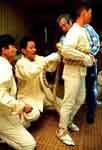 Participants dress in white underwear, a
white shirt, white tights and a straw rope
wrapped around their waist 5 or 7 times. Using
odd numbers is a Shinto. Each of these customs
carries a hidden symbolic meaning according to
the ancient Japanese Shinto tradition. Friends
help each other to dress up in the traditional
attire. First-time participants can get always
get help from the festival veterans.
Participants dress in white underwear, a
white shirt, white tights and a straw rope
wrapped around their waist 5 or 7 times. Using
odd numbers is a Shinto. Each of these customs
carries a hidden symbolic meaning according to
the ancient Japanese Shinto tradition. Friends
help each other to dress up in the traditional
attire. First-time participants can get always
get help from the festival veterans.
to the top- Tanomude("together we go")
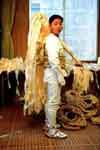 After dressing up in an all white outfit
topped with a white cap or a white bandanna
around the head, participants are ready to begin
the festival. After Noboriko (the participants of
this festival) leave their home in the evening
they gather with a group of friends or colleagues
to walk around Shingu performing what is called
'Sansha Mairi' (Three Shrines Visit). One by one
they gather and say prayers at Hayatama Grand
Shrine, Asuka Shrine, and Myoushinji Temple
before crossing the bridge at the entrance of
Kamikura Shrine. On their way to the three
shrines, they will pass many other participants
in the street. When they meet they greet one
another by saying 'Tanomude!' ('together we go').
As they pass by another group they will hit each
other's torch lightly as a kind of salute to
courage.
After dressing up in an all white outfit
topped with a white cap or a white bandanna
around the head, participants are ready to begin
the festival. After Noboriko (the participants of
this festival) leave their home in the evening
they gather with a group of friends or colleagues
to walk around Shingu performing what is called
'Sansha Mairi' (Three Shrines Visit). One by one
they gather and say prayers at Hayatama Grand
Shrine, Asuka Shrine, and Myoushinji Temple
before crossing the bridge at the entrance of
Kamikura Shrine. On their way to the three
shrines, they will pass many other participants
in the street. When they meet they greet one
another by saying 'Tanomude!' ('together we go').
As they pass by another group they will hit each
other's torch lightly as a kind of salute to
courage.
to the top- Ascending Kamikura
 Participants must
climb up an extremely steep stone pathway called
'Kamakurazumi' built over 800 years ago. The
first 200 steps out of 538 steps from the bottom
to the area called 'Nakanojizo' are so steep that
some have to get down on all fours. (These stone
steps are a prefectural cultural treasure of
Wakayama.) The participants climb up these
stonesteps slowly toward the precincts of the
shrine.
Participants must
climb up an extremely steep stone pathway called
'Kamakurazumi' built over 800 years ago. The
first 200 steps out of 538 steps from the bottom
to the area called 'Nakanojizo' are so steep that
some have to get down on all fours. (These stone
steps are a prefectural cultural treasure of
Wakayama.) The participants climb up these
stonesteps slowly toward the precincts of the
shrine.
to the top- Waiting for the Sacred Fire
 This picture
shows the grounds around the shrine on the inner
side of the 'torii' (shrine gateway). A priest
will start a small fire using flint stones and
the fire is then carried halfway down the
mountain to an area called Nakanojizo. It is then
brought back up to light the participants'
torches. When the approximately 2000 torches are
all lit it looks as if the mountain were on fire.
You can hear the participants' cheers roaring
throughout the city. It becomes a place of
feverish excitement, full of sparks of fire and
smoke. As soon as the Kaishakunin (the person who
guards the gate) opens the gate the participants
race down the stonesteps to see who can arrive at
the bottom first. From a distance it looks as
though a fire dragon were descending the
mountain.
This picture
shows the grounds around the shrine on the inner
side of the 'torii' (shrine gateway). A priest
will start a small fire using flint stones and
the fire is then carried halfway down the
mountain to an area called Nakanojizo. It is then
brought back up to light the participants'
torches. When the approximately 2000 torches are
all lit it looks as if the mountain were on fire.
You can hear the participants' cheers roaring
throughout the city. It becomes a place of
feverish excitement, full of sparks of fire and
smoke. As soon as the Kaishakunin (the person who
guards the gate) opens the gate the participants
race down the stonesteps to see who can arrive at
the bottom first. From a distance it looks as
though a fire dragon were descending the
mountain.
to the top- Myoushinji Temple
 This is
Myoushinji Temple, the ancient headquarters of
the Kumano Bikuni, the Japanese nuns who walked
all over Japan spreading the Kumano Gongen faith.
It is one of the three main places where
participants in the festival visit to pray. It is
located close to Kamikura Shrine which was paired
up with the temple in the time when Buddhism and
Shinto were unified.
This is
Myoushinji Temple, the ancient headquarters of
the Kumano Bikuni, the Japanese nuns who walked
all over Japan spreading the Kumano Gongen faith.
It is one of the three main places where
participants in the festival visit to pray. It is
located close to Kamikura Shrine which was paired
up with the temple in the time when Buddhism and
Shinto were unified.
to the top- Sharing the Sacred Fire
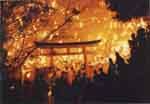
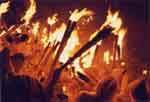 It becomes a place of
feverish excitement, full of sparks of fire and
smoke. As soon as the Kaishakunin (the person who
guards the gate) opens the gate the participants
race down the stonesteps to see who can arrive at
the bottom first. From a distance it looks as
though a fire dragon were descending the
mountain.
It becomes a place of
feverish excitement, full of sparks of fire and
smoke. As soon as the Kaishakunin (the person who
guards the gate) opens the gate the participants
race down the stonesteps to see who can arrive at
the bottom first. From a distance it looks as
though a fire dragon were descending the
mountain.
to the top